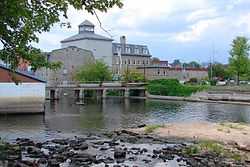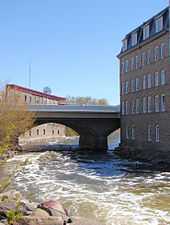Smiths Falls
| Smiths Falls | |
|---|---|
| Town | |
| Town of Smiths Falls | |
 | |
 | |
| Coordinates: 44°54′N 76°01′W / 44.900°N 76.017°WCoordinates: 44°54′N 76°01′W / 44.900°N 76.017°W | |
| Country |
|
| Province |
|
| County | Lanark |
| Incorporated | 1854 (as village) |
| Government | |
| • Mayor | Dennis W. Staples |
| • Federal riding | Lanark—Frontenac—Lennox and Addington |
| • Prov. riding | Lanark—Frontenac—Lennox and Addington |
| Area[1] | |
| • Land | 9.61 km2 (3.71 sq mi) |
| Population (2011)[1] | |
| • Total | 8,978 |
| • Density | 934.6/km2 (2,421/sq mi) |
| Time zone | Eastern (EST) (UTC−5) |
| • Summer (DST) | Eastern Daylight (EDT) (UTC−4) |
| Postal code FSA | K7A |
| Area code(s) | 613 |
| Website | www.smithsfalls.ca |
Smiths Falls is a town in Eastern Ontario, Canada, with a population of 8,978 at the 2011 census. It is in the census division for Lanark County, but is considered a separated town and does not participate in county government. The Rideau Canal waterway passes through the town, with four separate locks in three locations and a combined lift of over 15 metres (50 ft).
The town's name was sometimes alternatively spelled "Smith's Falls" or "Smith Falls", but "Smiths Falls" is now considered correct.
History
Early history
The city is named for Thomas Smyth, a United Empire Loyalist who in 1786 was granted 400 acres (1.6 km2) in what is present-day Smiths Falls. The Heritage House Museum (c. 1862) also known as the Ward House, was designated under the Ontario Heritage Act in 1977.[2]
Building of the Rideau Canal

At the time of construction of the Rideau Canal a small settlement had been established around a mill operated by Abel Russell Ward, who had bought Smyth's land. Colonel By ordered the removal of Ward's mill to make way for the canal. He settled with Ward for £1,500, one of the largest claims made by mill owners on the canal.
The disruption of industry caused by the building of the canal was only temporary, and Smiths Falls grew rapidly following construction. An article in Smith's Gazetteer in 1846 described the town as a "flourishing little village pleasantly situated on the Rideau River and on the Canal, fourteen miles (21 km) from Perth. It contains about 700 inhabitants. There are fifty dwellings, two grist mills (one with four run of stones), two sawmills, one carding and fulling mill, seven stores, six groceries, one axe factory, six blacksmiths, two wheelwrights, one cabinet maker, one chair-maker, three carpenters, one gunsmith, eleven shoemakers, seven tailors, one tinsmith and two taverns."
A 36-foot (11 m) drop in less than a quarter of a mile posed an obstacle to navigation at Smiths Falls. A natural depression to the south of the river was used to create a flight of three locks, known as Combined Lockstation today. The natural course of the river was dammed to create a basin upstream of the locks. At the upper end of the basin a fourth (detached) lock was constructed.
A mile below the Combined Lockstation is a flight of two locks called the Old Slys Lockstation. This station is named for the original settler at this location, William Sly. A dam and waste weir control water levels upstream of the locks.
Defensible lockmasters' houses were built at all three stations in Smiths Falls. The house at Old Slys was built in 1838 and the houses at Combined and Detached around 1842. Only the house at Combined has a second storey, which was added late in the 19th century. The defensible lockmaster's house at Detached Lockstation was torn down in 1894.
Entry of the railways
In the 1850s the major railway companies were looking to build main trunk lines linking Toronto, Kingston and Montreal. The two major companies at the time, the Brockville & Ottawa and the Grand Trunk Railway, were competing for the easiest routes to lay track. For a number of geographical reasons, and also due to the proximity of the Rideau Canal, the town of Smiths Falls became a major focal point for both railways. Both the Canadian Pacific and the Canadian Northern (later Canadian National) established stations in the town, however, with the creation of Via Rail, the CN station was abandoned and all passenger traffic routed though the CPR station. The CN station has been renovated and is now home to the Smiths Falls Railway Museum of Eastern Ontario. The railway station, along with the nearby railway bascule bridge, comprise the town's two National Historic Sites of Canada.[3][4]
During World War II, Axis prisoners of war (POWs) were transported to Canadian POW camps via the railway. It was near Smiths Falls that German soldier Oberleutnant Franz von Werra jumped from a POW train and escaped to the United States, eventually reaching his homeland.[5] Von Werra was, reputedly, the only escaped Axis POW to successfully return home during the war and his story was told in the book and film entitled The One That Got Away.[6] The North American premiere of the film occurred on Thursday, 6 March 1958 at the Soper Theatre in Smiths Falls.[7]
Demographics
| Census | Population |
|---|---|
| 1871 | 1,150 |
| 1881 | 2,087 |
| 1891 | 3,864 |
| 1901 | 5,155 |
| 1911 | 6,370 |
| 1921 | 6,790 |
| 1931 | 7,108 |
| 1941 | 7,088 |
| 1951 | 8,441 |
| 1961 | 9,603 |
| 1971 | 9,585 |
| 1981 | 8,831 |
| 1991 | 9,396 |
| 2001 | 9,140 |
| 2006 | 8,777 |
| 2011 | 8,978 |
| |||||||||||||||||
Economy
The town is on the Rideau Canal system for recreational boating, and is served by the Smiths Falls-Montague Airport for general aviation. It is also a major railway junction point, and its station receives regular passenger service to Ottawa and Toronto from Via Rail.
Several manufacturers were based in Smiths Falls, perhaps the most well-known being the Canadian operation of The Hershey Company which closed in December 2008.[11] Hershey announced they will instead open a factory in Mexico where they can have cheaper labour. In late 2006, the plant was temporarily closed due to a case of possible salmonella contamination.[12][13] Other former large manufacturers include RCA Victor (closed circa 1980), Frost and Wood / Cockshutt and Stanley Tools (2008).
The Ontario Provincial Police Eastern Region Communications Centre is also located in Smiths Falls. Its communications operators answer emergency 9-1-1 and administrative phone lines, dispatching OPP officers as required.
Sports and recreation
In 1906, a hockey team from Smiths Falls launched an unsuccessful challenge to win the Stanley Cup.[14] Smiths Falls was home to a professional baseball team, the Smiths Falls Beavers, for one season in 1937. The team was a part of the Canadian-American League.
The town is currently home to the Junior A hockey team Smiths Falls Bears, who play in the Central Canada Hockey League.
Education
Public education in the town is managed by the Upper Canada District School Board, while Catholic education is under the care of the Catholic District School Board of Eastern Ontario. Each operates several elementary schools and one secondary school:
Catholic schools
- St. James The Greater Catholic Elementary School
- St. Francis de Sales Catholic Elementary School
- St. Luke's Catholic High School (Alternative school)
Public schools
- Duncan J. Schoular Public School
- Chimo Elementary School
- Smiths Falls District Collegiate Institute
Notable people
- NHL ice hockey players Terry Carkner, Gary McAdam and Don McKenney
Hospitals
General hospital facilities and services are provided by the Perth and Smiths Falls District Hospital, with a site on Cornelia Street. Also located in Smiths Falls was the Rideau Regional Centre, which provided a residential program for mentally challenged and disabled persons from 1951 until its closure in March 2009.[15]
Local media
- The Record-News EMC - weekly newspaper
- Smiths Falls This Week - weekly newspaper
- CJET-FM - Jack FM, adult hits radio station
- CKBY-FM - Y101, country music radio station
Nearest cities
- Ottawa - about 75 kilometres (47 mi) north-east
- Brockville - about 50 kilometres (31 mi) south-east
- Kingston - about 95 kilometres (59 mi) south-west
- Neighbouring municipalities
 |
Montague |  | ||
| Drummond/North Elmsley | |
Montague | ||
| ||||
| | ||||
| Rideau Lakes | Merrickville–Wolford |
References
- ↑ 1.0 1.1 "Smiths Falls census profile". 2011 Census of Population. Statistics Canada. Retrieved 2012-02-14.
- ↑ Heritage House Museum. Canadian Register of Historic Places.
- ↑ Smiths Falls Railway Station (Canadian Northern). Canadian Register of Historic Places.
- ↑ Smiths Falls Bascule Bridge. Canadian Register of Historic Places.
- ↑ Barron Von Werra Begins Tour of "Sights" After Arrival in New York City - January 27, 1941
- ↑ Franz von Werra
- ↑ The One That Got Away
- ↑ "2011 Community Profiles". Canada 2011 Census. Statistics Canada. July 5, 2013. Retrieved 2012-02-14.
- ↑ "2006 Community Profiles". Canada 2006 Census. Statistics Canada. March 30, 2011. Retrieved 2012-02-14.
- ↑ "2001 Community Profiles". Canada 2001 Census. Statistics Canada. February 17, 2012. Retrieved 2012-02-14.
- ↑ CBC.ca: Hershey confirms Smiths Falls plant will close
- ↑
- ↑
- ↑ NHL.com - The Stanley Cup
- ↑ Koskie Minsky LLP: Rideau Regional Centre
External links
| Wikisource has the text of the 1911 Encyclopædia Britannica article Smith's Falls. |
| Wikimedia Commons has media related to Smiths Falls. |
- Smiths Falls town site
- Smiths Falls Police Service note: The town is not policed by the OPP.
- Smiths Falls Bethel Pentecostal Church
- Smiths Falls Free Methodist Church
- St Francis de Sales Catholic Church
- Smiths Falls Public Library
- Smiths Falls Marketplace
- Smiths Falls Chamber of Commerce
| |||||||||||||||||||||||
